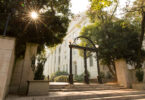Athens, Ga. – The Georgia Museum of Art at the University of Georgia will present a lunch and learn event for faculty focusing on the intersections between science/engineering and art on Aug. 17 from 12-1 p.m. in the museum’s Educational Outreach Center. Lynn Boland, Pierre Daura Curator of European Art, will address the importance of science and technology in the creation of works of art, focusing on three exhibitions on view at GMOA this fall semester, two of which will continue into spring semester.
“The New York Collection for Stockholm,” on view Aug. 18-Oct. 28, will feature prints by many boldface names, including Andy Warhol, Roy Lichtenstein and Cy Twombly. Assembled in the early 1970s by a New York-based group called Experiments in Art and Technology, the portfolio of prints funded the purchase of a collection of contemporary American art that was ultimately housed at the Moderna Museet in Stockholm. E.A.T. focused its attentions on collaborations between artists and engineers, organizing events and facilitating interactions among the disciplines. E.A.T. projects led to advancements in areas as wide-ranging as irrigation, outdoor air conditioning, surround sound and mirror optics.
“De Wain Valentine: Human Scale,” on view Sept. 8-Jan. 27, will have the largest number of the California artist’s large-scale resin sculptures ever exhibited. Artists of the 1960s and 1970s frequently used industrial materials and techniques, but none was as involved in the process and production as Valentine. Faced with what the plastics industry thought impossible at the time-the large-scale casting of polyester resin-the artist, through meticulous experimentation with ratios of catalyst and with casting techniques, found a way to make it work. Marketed under the name Valentine MasKast Resin, the material and process was made commercially available for a wide range of applications, from use by other artists to kitchen countertops.
“The Hermes Relief Project,” taking place from mid-September-March 10, will involve collaboration among many departments on UGA’s campus as well as with the University of Mississippi. For centuries, the notion of ancient Greek and Roman sculpture was one of pristine white marble; however, ancient marbles were brightly painted to further their naturalism. The Hermes Relief Project involves the examination, study and analysis of minute traces of color on an ancient relief fragment from the collection of the University of Mississippi Museum, Oxford, Miss., and its contextualization for art historical and cultural histories. UGA art and art history students, as well as students and faculty in the sciences and humanities, will be included in the project.
The principal participants are Mark Abbe, formerly a research scholar and conservator with the Metropolitan Museum of Art, now assistant professor of art at UGA, who specializes in the analysis of extant pigment on ancient sculpture; Boland; Carissa DiCindio, curator of education at GMOA; and participants from UGA’s Center for Isotopic Studies, the Center for Archaeological Science, the department of chemistry and the department of classics, all in collaboration with faculty and students from the University of Mississippi.
Boxed lunches will be provided at the Lunch and Learn. For reservations to this free event, email DiCindio at cdicindi@uga.edu or call 706/583-0111 by Aug 14.
Museum Information
Partial support for the exhibitions and programs at the Georgia Museum of Art is provided by the Georgia Council for the Arts through appropriations of the Georgia General Assembly. The council is a partner agency of the National Endowment for the Arts. Individuals, foundations and corporations provide additional museum support through their gifts to the University of Georgia Foundation. The Georgia Museum of Art is located in the Performing and Visual Arts Complex on the East Campus of UGA. The address is 90 Carlton Street, Athens, Ga. 30602-6719. For more information, including hours, see www.georgiamuseum.org or call 706/542-GMOA (4662).
##




